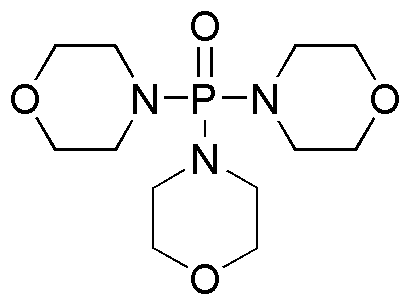Trimorpholinophosphine oxide is widely utilized in research focused on:
- Pharmaceutical Development: It serves as a key intermediate in the synthesis of various pharmaceuticals, enhancing the efficiency of drug formulation processes.
- Catalysis: This compound acts as a catalyst in organic reactions, particularly in the synthesis of complex molecules, improving reaction rates and yields.
- Polymer Chemistry: It is employed in the production of specialty polymers, contributing to materials with enhanced properties such as durability and resistance to environmental factors.
- Environmental Applications: Trimorpholinophosphine oxide is used in the development of biodegradable materials, addressing the growing need for sustainable solutions in various industries.
- Analytical Chemistry: It plays a role in analytical methods for detecting and quantifying phosphine derivatives, aiding researchers in environmental monitoring and safety assessments.
General Information
Properties
Safety and Regulations
Applications
Trimorpholinophosphine oxide is widely utilized in research focused on:
- Pharmaceutical Development: It serves as a key intermediate in the synthesis of various pharmaceuticals, enhancing the efficiency of drug formulation processes.
- Catalysis: This compound acts as a catalyst in organic reactions, particularly in the synthesis of complex molecules, improving reaction rates and yields.
- Polymer Chemistry: It is employed in the production of specialty polymers, contributing to materials with enhanced properties such as durability and resistance to environmental factors.
- Environmental Applications: Trimorpholinophosphine oxide is used in the development of biodegradable materials, addressing the growing need for sustainable solutions in various industries.
- Analytical Chemistry: It plays a role in analytical methods for detecting and quantifying phosphine derivatives, aiding researchers in environmental monitoring and safety assessments.
Documents
Safety Data Sheets (SDS)
The SDS provides comprehensive safety information on handling, storage, and disposal of the product.
Product Specification (PS)
The PS provides a comprehensive breakdown of the product’s properties, including chemical composition, physical state, purity, and storage requirements. It also details acceptable quality ranges and the product's intended applications.
Certificates of Analysis (COA)
Search for Certificates of Analysis (COA) by entering the products Lot Number. Lot and Batch Numbers can be found on a product’s label following the words ‘Lot’ or ‘Batch’.
*Catalog Number
*Lot Number
Certificates Of Origin (COO)
This COO confirms the country where the product was manufactured, and also details the materials and components used in it and whether it is derived from natural, synthetic, or other specific sources. This certificate may be required for customs, trade, and regulatory compliance.
*Catalog Number
*Lot Number
Safety Data Sheets (SDS)
The SDS provides comprehensive safety information on handling, storage, and disposal of the product.
DownloadProduct Specification (PS)
The PS provides a comprehensive breakdown of the product’s properties, including chemical composition, physical state, purity, and storage requirements. It also details acceptable quality ranges and the product's intended applications.
DownloadCertificates of Analysis (COA)
Search for Certificates of Analysis (COA) by entering the products Lot Number. Lot and Batch Numbers can be found on a product’s label following the words ‘Lot’ or ‘Batch’.
*Catalog Number
*Lot Number
Certificates Of Origin (COO)
This COO confirms the country where the product was manufactured, and also details the materials and components used in it and whether it is derived from natural, synthetic, or other specific sources. This certificate may be required for customs, trade, and regulatory compliance.


